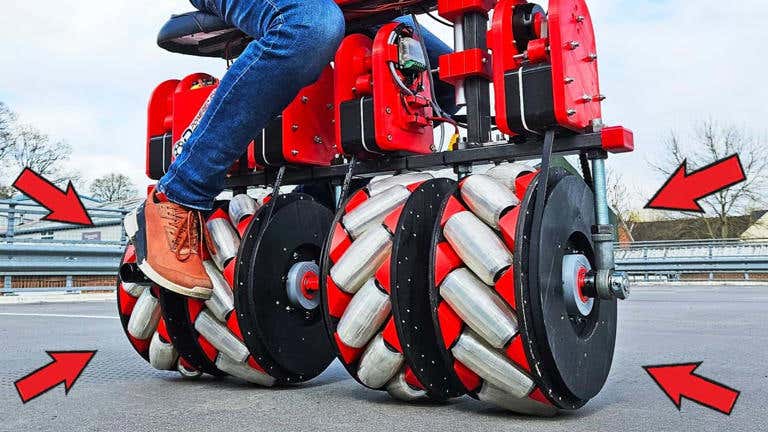World’s first electric screw bike is powered by 3D-printed wheels
By positioning and driving the wheels, the bike achieves a unique screw-like motion, allowing riders to maneuver in any direction

Meet James Bruton, a mechanical engineer, inventor, roboticist, and YouTube sensation. His channel isn't just about DIY projects; it's a showcase of his multifaceted skills and passion for innovation.
Bruton's videos feature a variety of projects, from a walking Star Wars droid to ongoing series on balancing robots. What sets him apart is his knack for clear demonstrations and explanations, making complex concepts accessible to viewers. He's not just building; he's teaching and inspiring others to explore their creativity.
One of Bruton's latest creations is a screw bike, which he describes as "mega-bonkers." Unlike traditional bikes, this one uses four mecanum wheels, typically found in industrial machines and robots, for omnidirectional movement. By strategically positioning and driving these wheels, the bike achieves a unique screw-like motion, allowing riders to maneuver in any direction.
Before showcasing the bike in action, Bruton documented its construction process. Much of the wheel components are 3D printed using various materials and techniques. Plywood and durable materials are used for different parts, ensuring stability and safety. Multiple bearings are meticulously installed to ensure smooth operation, highlighting Bruton's attention to detail and commitment to safety.
The initial test on Bruton's kitchen floor reveals some sliding issues, quickly resolved by wearing shoes for better grip. Transitioning to a nearby parking lot, Bruton demonstrates the bike's capabilities.
An electronic control box, programmed by Bruton, regulates the movement of the wheels, providing stability and control similar to his balancing robots.
Related Stories
The bike's hand controls, though unconventional, are intuitive once explained. Twist grips on both sides, coupled with toggle switches, dictate the bike's direction.
Unlike traditional motorcycles, there are no foot controls, a deliberate choice by Bruton to ensure ease of operation and protection of controls in case of falls.
Viewers eagerly anticipate future videos showcasing the bike's performance on challenging courses, demonstrating its handling and agility. While its speed remains unspecified, the mere existence of such a unique creation is a testament to Bruton's ingenuity and expertise.
What's even more exciting is that Bruton shares his CAD designs and code freely, encouraging others to replicate or modify his creations. His GitHub repository provides access to all the necessary resources, fostering a collaborative and open-source community of makers.
James Bruton's screw bike is not just a marvel of engineering; it's a symbol of innovation and collaboration in the maker community. Through his videos and open-source approach, Bruton inspires others to push the boundaries of creativity and technology.
Whether you're a seasoned engineer or an aspiring DIY enthusiast, Bruton's work reminds us that with passion and determination, anything is possible.
For more science news stories check out our New Innovations section at The Brighter Side of News.
Note: Materials provided above by The Brighter Side of News. Content may be edited for style and length.
Like these kind of feel good stories? Get the Brighter Side of News' newsletter.
Joseph Shavit
Head Science News Writer | Communicating Innovation & Discovery
Based in Los Angeles, Joseph Shavit is an accomplished science journalist, head science news writer and co-founder at The Brighter Side of News, where he translates cutting-edge discoveries into compelling stories for a broad audience. With a strong background spanning science, business, product management, media leadership, and entrepreneurship, Joseph brings a unique perspective to science communication. His expertise allows him to uncover the intersection of technological advancements and market potential, shedding light on how groundbreaking research evolves into transformative products and industries.



